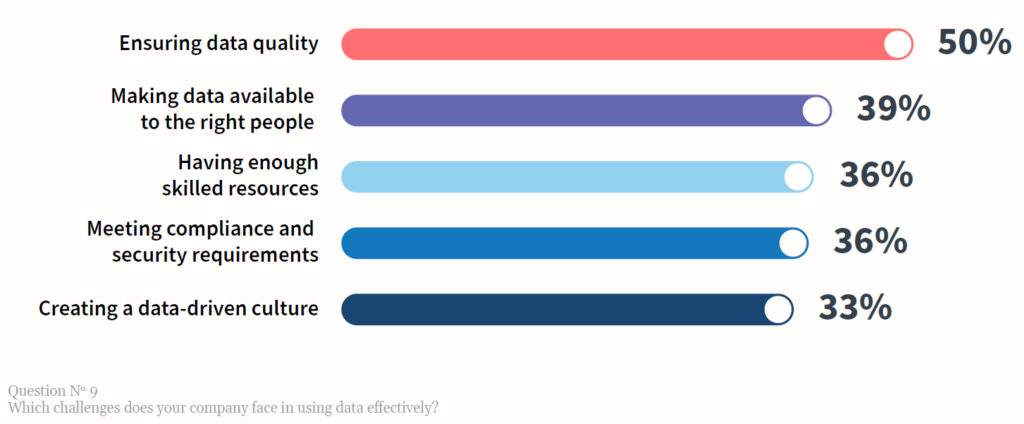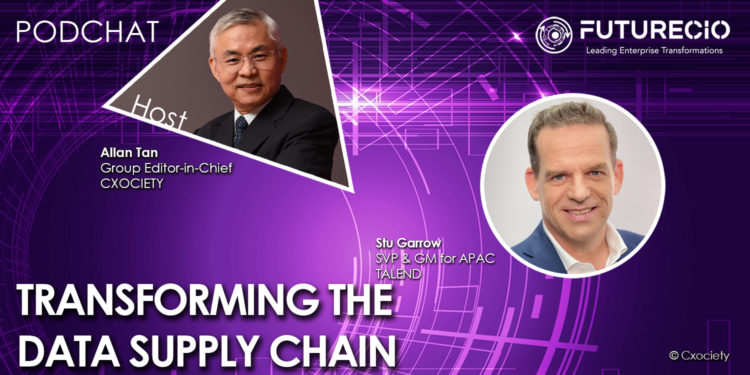Data, data everywhere. Not a drop of insight.
At times this rings true. Organisations have mastered the art of capturing data in all its forms, regardless of whether it is structured or unstructured. But the abundance of data – 74 zettabytes created just in 2021 alone, means nothing when we are unable to understand what it means and therefore make decisions based on the data.
Indeed, the proliferation of data has created new opportunities as promised by data democratisation. But it also opened challenges for organisations including security, the proliferation of low-quality data, and regulatory compliance issues.
Stu Garrow, SVP & GM for APAC at Talend, says data generates a lot of value for companies. Talend’s 2021 Data Health Survey revealed that 96% of APAC executives have trouble accessing and working with data, while 36% stated that they don’t use the data and prefer to rely on intuition when it comes to making business decisions.

Source: Data Health Survey, Talend, 2021
“In these uncertain economic times, making critical decisions require data and if an organisation cannot trust their data – which is a crucial step – they will miss out on being truly data-driven,” said Garrow.
What a data supply chain is and isn’t
That data is the lifeblood of economies and businesses is no longer contested. Access to data is what enables businesses or governments to decide on the direction they wish to take.

In a Forbes article, Samuel Ethiopia, CEO of DocSpera, wrote: “Having a clear understanding of the data’s purpose and chain of custody is the most important step in setting up a data supply chain.
"End-to-end knowledge of the chain of custody allows you to ensure data quality, compliance and reliability. Developing a clear data flow architecture with each stakeholder is a critical step once the purpose and goal are established.”
Samuel Ethiopia
But to build a data supply chain that delivers on the aspirations of its users presents multiple challenges.

Source: Data Health Survey, Talend, 2021
Garrow cautions that a supply chain is a series of solutions that can add value to a product; data is no different as every company has its own supply chain of data. Today, most large organisations have over 400 sources of enterprise data.
“The data supply chain gathers generated data together to create valuable data that can help companies make business decisions. Companies must be able to unlock the value of this data which can then be consumed to generate value for their businesses,” he continued.
The data maturity journey
Organisations that have committed to digital transformation will discover that they need to mature in how they create and consume data along their journey.

But as Nicolas Quairel, partner and global head of tech and digital consulting at Mazars, says “countless businesses are racing towards the same objective: to be data-driven. However, our findings underscore the inherent difficulty of this journey. The path to data maturity is often longer, more complex, and more fraught with challenges than business leaders anticipate – or even realise.”
Garrow believes that each company is on a different path to digital maturity and therefore they focus on different data management issues. He opined that the concept of data health helps companies deliver the best outcomes for their businesses.
“The data health journey consists of these steps: firstly, companies must identify business objectives that require data, secondly, they must determine which set of data to use, and thirdly, they must recognise the current obstacles they have that stop them from harnessing the value of this data,” he added.
The purpose of SGTraDex
In Singapore, a group of government and private sector organisations banded together to provide a new type of public and neutral infrastructure in a digital era that allows for data connections to be made to a wide range of data contributors and data users across the world.
SGTraDex is a centralised data platform that acts as a "common data highway" across the global supply chain ecosystem to plug gaps in supply chains, which traditionally relied heavily on a paper-based system that lacked efficiency, transparency, and sustainability.
What SGTraDex teaches us
SGTraDex was created to solve the complex problem of digitalising the supply chain ecosystem.
“This is a common pain point for the industry and in our Data Health Survey we found that 86% of companies are trying to optimise their internal data management, but only 20% have seen results from launching similar initiatives,” said Garrow.
He believes that many regional players will try to replicate SGTraDex, but the task will not be easy, and Singapore has had years to hone its skills around building long-term strategies. The SGTraDex platform puts Singapore in a leading position within the ecosystem and is poised for success.
With the launch of SGTraDex, can participants in the digital supply chain now let down their guard against data infringement from cyber criminals?
According to Garrow, the platform should be able to protect its participants from cyberattacks, and the recent proliferation of cybersecurity issues within APAC leads to the issue of trust.

“Trust in the technology industry does not only refer to digital security but incorporates a human aspect: companies will trust their data more if many other organisations also trust the same data. Moreover, to detect bad data we recommend the use of a trust score which can identify data that cannot be trusted."
Stu Garrow
Improving the effectiveness and quality of their data
Companies should have a single data platform in place that can manage all their data; it should be considered an asset and it should be able to continuously handle a variety of use cases.
“Organisations must also ensure that the relevant people have access to this platform and the data. Subsequently, organisations should begin their data health journey and foster a culture of trusting data; once this data is trusted and valued, they can make data-driven business decisions that support their objectives,” concluded Garrow.
Click on the PodChat player above to listen to Garrow’s advice on how to improve the effectiveness of your organisation’s data.
- When working with enterprise data to make decisions, why is it crucial that executives can trust their data rather than just using their intuition?
- Define for us what a data supply chain is, as well as what it is not.
- What are the measures companies can take to achieve digital/data maturity to mitigate supply chain disruptions?
- How do you view the progression of Singapore’s supply chain (in terms of digitalisation), and how can the wider APAC ecosystem learn and benefit from the creation of SGTraDex?
- Cyberattacks against supply chains are becoming more frequent, aggressive, and disruptive. Can participants in the digital supply chain let down their guard against cyber criminals with SGTraDex?
- What is your advice for companies looking to improve the effectiveness and quality of their data?





